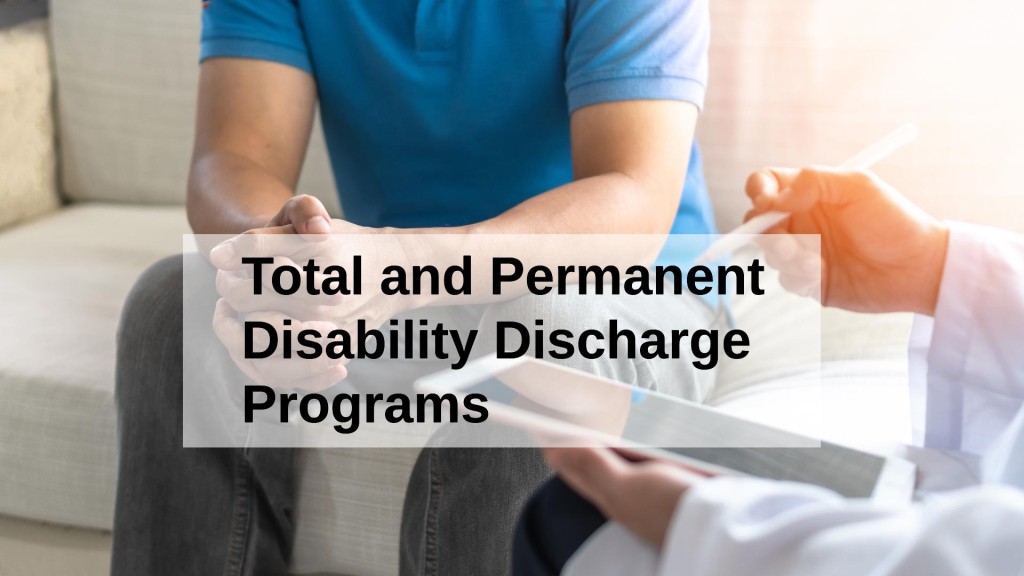Survivors’ and Dependents’ Educational Assistance Program
Explore educational assistance for survivors and dependents. Learn about benefits, eligibility, and how to apply for this valuable program

Discover how Total and Permanent Disability Student Loan Discharge Programs offer relief for borrowers facing debilitating conditions. Learn more here.
Student loans can be a significant financial burden for many individuals, and for those who experience total and permanent disabilities, managing these loans can become even more challenging. Fortunately, there are programs in place to provide relief for borrowers facing such circumstances. In this blog post, we will delve into the topic of Total and Permanent Disability (TPD) Student Loan Discharge Programs, exploring what they entail, who qualifies, how to apply, and the impact of these programs on borrowers.
Table of contents [Show]
Total and permanent disability refers to a condition that prevents an individual from engaging in substantial gainful activity and is expected to last for a continuous period of at least 60 months or result in death. Disabilities can stem from various sources, including accidents, illnesses, or mental health conditions. For those grappling with total and permanent disabilities, the ability to work and generate income is severely limited, making the repayment of student loans a daunting task.
Recognizing the financial challenges faced by borrowers dealing with total and permanent disabilities, the U.S. Department of Education has established discharge programs to provide relief. These programs aim to alleviate the financial strain on individuals who are unable to work due to their disabilities, allowing them to move forward without the burden of student loan debt.
Several Total and Permanent Disability Discharge Programs are available to borrowers, each with its own set of criteria and requirements. The main programs include:
Total and Permanent Disability (TPD) Discharge for Federal Student Loans: This program applies to borrowers with federal student loans, including Direct Loans, Federal Family Education Loans (FFEL), and Perkins Loans.
Discharge for Veterans: Disabled veterans may be eligible for a Total and Permanent Disability Discharge through the U.S. Department of Veterans Affairs (VA).
Social Security Disability Discharge: Borrowers who receive Social Security Disability Insurance (SSDI) or Supplemental Security Income (SSI) benefits may qualify for student loan discharge.
To qualify for Total and Permanent Disability Student Loan Discharge, borrowers must meet specific criteria. These criteria may include:
Medical Documentation: Providing medical documentation verifying the total and permanent nature of the disability is a crucial step. This documentation can come from a licensed physician, the U.S. Department of Veterans Affairs, or the Social Security Administration.
Receiving Disability Benefits: Borrowers receiving disability benefits through the VA or Social Security Administration may automatically qualify for TPD discharge.
Review by a Physician: In some cases, borrowers may need to undergo a review by a physician designated by the U.S. Department of Education to confirm the total and permanent nature of their disability.
Applying for TPD discharge involves a specific process, and borrowers should follow the outlined steps to ensure a smooth application. Key steps include:
Obtaining the Application Form: Borrowers can obtain the TPD discharge application form from the official website of the U.S. Department of Education.
Completing the Application: The application form must be completed accurately, providing all necessary information and supporting documentation.
Submitting the Application: Once completed, the application should be submitted to the U.S. Department of Education. Borrowers with federal student loans can submit the form online, while those with Perkins Loans may need to submit a paper application.
Monitoring the Application Status: After submission, borrowers can monitor the status of their TPD discharge application through the U.S. Department of Education's online portal.
The approval of a TPD discharge application has significant implications for borrowers. Upon approval:
Loan Forgiveness: The outstanding balance of the qualifying student loans is forgiven, relieving the borrower of the obligation to repay the debt.
Reimbursement of Prior Payments: Borrowers who made payments on their loans after the date of their disability may be eligible for reimbursement.
Tax Implications: While the forgiven loan amount is not considered taxable income for federal tax purposes, borrowers should be aware of potential state tax implications.
Sharing success stories of individuals who have successfully navigated the TPD discharge process can provide encouragement and guidance for others facing similar challenges. These stories can highlight the relief and positive impact that loan discharge has had on the lives of borrowers dealing with total and permanent disabilities.
While Total and Permanent Disability Discharge Programs offer crucial support, there are challenges and criticisms associated with these programs. Some common concerns include:
Documentation Requirements: Meeting the stringent documentation requirements can be challenging for some borrowers, leading to delays in the application process.
Complex Application Process: The application process itself can be complex, requiring careful attention to detail. Some borrowers may find it difficult to navigate without assistance.
Limited Awareness: Many eligible individuals may be unaware of the existence of TPD discharge programs, leading to missed opportunities for relief.
Understanding how Total and Permanent Disability Discharge compares to other loan discharge and repayment programs is essential for borrowers. Comparisons with programs such as Public Service Loan Forgiveness (PSLF) or income-driven repayment plans can help individuals make informed decisions about the best course of action for their specific circumstances.
Total and Permanent Disability Student Loan Discharge Programs play a crucial role in supporting individuals facing the challenges of total and permanent disabilities. By offering a pathway to loan forgiveness, these programs empower borrowers to focus on their health and well-being without the overwhelming burden of student loan debt. As awareness grows and the application process becomes more accessible, more individuals can benefit from these vital programs, ensuring that no one is left unduly burdened by student loan debt due to circumstances beyond their control.
What is a Total and Permanent Disability (TPD) Student Loan Discharge Program?
It's a federal program that forgives student loans if the borrower is unable to work due to a total and permanent disability.
Who qualifies for TPD discharge?
Individuals who are totally and permanently disabled, as certified by the Social Security Administration (SSA) or by a physician, can qualify.
What types of student loans are eligible for TPD discharge?
Federal Direct Loans, Federal Family Education Loans (FFEL), and Federal Perkins Loans are eligible. Private loans are not.
Is there an age limit for TPD discharge?
No, there is no age limit for qualifying for TPD discharge.
Do I have to be unable to work to qualify for TPD discharge?
Yes, you must be unable to engage in substantial gainful activity due to the disability.
Can I apply for TPD discharge if I am currently in the process of receiving Social Security Disability Insurance (SSDI) or Supplemental Security Income (SSI)?
Yes, you can apply with a SSA notice of award for SSDI or SSI benefits.
How do I apply for TPD discharge?
You can apply online through the Department of Education's website or by submitting a paper application with supporting documentation.
Is there a waiting period before I can apply for TPD discharge?
No, you can apply as soon as you believe you meet the eligibility requirements.
Will my loans be forgiven immediately after approval?
Not necessarily. There may be a three-year monitoring period to ensure you remain totally and permanently disabled.
Will my forgiven loans be taxed as income?
Generally, no. Under current tax laws, TPD discharge is not considered taxable income.
Can I qualify for TPD discharge if I am still able to work but have a low income?
No, TPD discharge is specifically for individuals who are unable to work due to a total and permanent disability.
Can I reapply for student loans after receiving TPD discharge?
Typically, if you receive TPD discharge, you cannot receive federal student aid in the future unless you prove your condition has improved.
Can my TPD discharge be revoked?
In certain circumstances, such as if you return to substantial gainful activity or fail to provide required documentation during the monitoring period, your discharge could be revoked.
Can I consolidate my loans before applying for TPD discharge?
Yes, you can consolidate eligible loans into a Direct Consolidation Loan before applying for TPD discharge.
What if I am unable to sign the application for TPD discharge due to my disability?
You can have a representative sign on your behalf, such as a legal guardian or someone with power of attorney.
Explore educational assistance for survivors and dependents. Learn about benefits, eligibility, and how to apply for this valuable program
Discover the benefits of the Montgomery GI Bill for military service members. Get education and training assistance. Learn more now
Unlock your future with the Post 9/11 GI Bill. Get education benefits for veterans. Pursue your dreams with tuition, housing, and more covered

